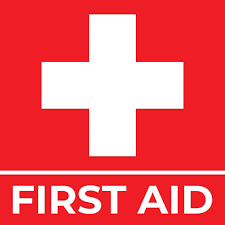
First aid
First Aids
First aid is the initial care given to a person who is injured or suddenly ill, before professional medical help can be provided. It aims to preserve life, prevent the condition from worsening, and promote recovery.
Basic Principles of First Aid:
- Assess the Situation: Ensure the area is safe for you and the injured person.
- Call for Help: Dial emergency services (e.g., 911) if the situation requires professional medical attention.
- Provide Care: Follow the steps of first aid based on the specific injury or illness.
ABC
The ABC acronym in first aid stands for the three critical steps to follow when assessing and managing a medical emergency: Airway, Breathing, and Circulation. These steps are essential for preserving life and preventing further harm.
ABC in First Aid:
- A - Airway
- Goal: Ensure the person's airway is clear and unobstructed.
- Steps:
- Check if the airway is open.
- If the person is unconscious, gently tilt their head back and lift their chin to open the airway.
- Remove any visible obstructions, such as food or foreign objects, but do not blindly sweep your fingers in their mouth.
- B - Breathing
- Goal: Confirm if the person is breathing adequately.
- Steps:
- Look for chest movement.
- Listen for the sound of breathing.
- Feel for breath on your cheek.
- If not breathing, start rescue breathing or CPR if trained.
- C - Circulation
- Goal: Ensure there is blood flow and address severe bleeding or cardiac arrest.
- Steps:
- Check for a pulse (neck or wrist) if you're trained to do so.
- Look for signs of severe bleeding and control it with direct pressure.
- If no pulse or signs of life, begin chest compressions (part of CPR).
RICE IN SPORTS
RICE is an acronym commonly used in first aid to manage soft tissue injuries such as sprains, strains, and bruises. It stands for Rest, Ice, Compression, and Elevation and aims to reduce pain, swelling, and promote healing.
RICE Method:
- R - Rest
- What to Do: Avoid using the injured area to prevent further damage.
- Why: Resting reduces stress on the injured tissue and allows healing to begin.
- I - Ice
- What to Do: Apply an ice pack (wrapped in a cloth) to the injured area for 15-20 minutes every 1-2 hours in the first 48 hours after the injury.
- Why: Ice helps reduce swelling and numbs pain by constricting blood vessels.
- Caution: Do not apply ice directly to the skin to prevent frostbite.
- C - Compression
- What to Do: Wrap the injured area with an elastic bandage or compression wrap. Make sure it's snug but not too tight.
- Why: Compression minimizes swelling and provides support to the injured area.
- Caution: Ensure blood flow is not restricted; loosen the wrap if numbness or tingling occurs.
- E - Elevation
- What to Do: Keep the injured area raised above the level of the heart whenever possible.
- Why: Elevation reduces swelling by allowing fluid to drain away from the injured area.